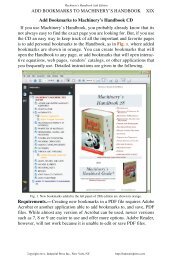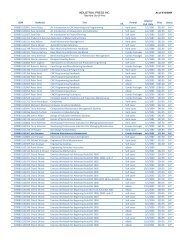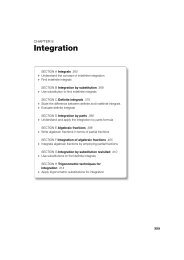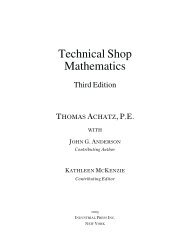computer numerical control programming basics - Industrial Press
computer numerical control programming basics - Industrial Press
computer numerical control programming basics - Industrial Press
You also want an ePaper? Increase the reach of your titles
YUMPU automatically turns print PDFs into web optimized ePapers that Google loves.
format that the machine <strong>control</strong> unit can understand. The format<br />
used on any CNC machine is built in by the machine tool builder<br />
and is based on the type of <strong>control</strong> unit on the machine. A variable-block<br />
format which uses words (letters) is most commonly<br />
used. Each instruction word consists of an address character,<br />
such as X, Y, Z, G, M, or S. Numerical data follows this address<br />
character to identify a specific function such as the distance, feed<br />
rate, or speed value.<br />
The address code G90 in a program, tells the <strong>control</strong> that all<br />
measurements are in the absolute mode. The code G91, tells the<br />
<strong>control</strong> that measurements are in the incremental mode.<br />
Codes<br />
The most common codes used when <strong>programming</strong> CNC machines<br />
tools are G-codes (preparatory functions), and M codes<br />
(miscellaneous functions). Other codes such as F, S, D, and T are<br />
used for machine functions such as feed, speed, cutter diameter<br />
offset, tool number, etc.<br />
G-codes are sometimes called cycle codes because they refer to<br />
some action occurring on the X, Y, and/or Z axis of a machine tool,<br />
Fig. 13.<br />
The G-codes are grouped into categories such as Group 01,<br />
containing codes G00, G01, G02, G03. which cause some movement<br />
of the machine table or head. Group 03 includes either<br />
absolute or incremental <strong>programming</strong>, while Group 09 deals with<br />
canned cycles.<br />
A G00 code rapidly positions the cutting tool while it is above the<br />
workpiece from one point to another point on a job. During the<br />
rapid traverse movement, either the X or Y axis can be moved<br />
individually or both axes can be moved at the same time. Although<br />
the rate of rapid travel varies from machine to machine, it ranges<br />
between 200 and 800 in./min (5 and 20 m/min).<br />
18








